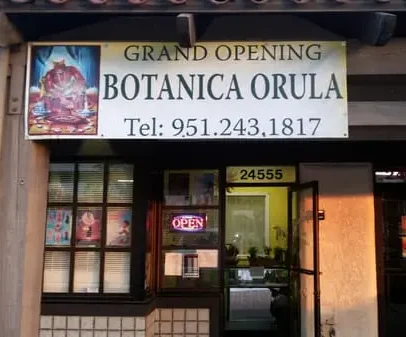Address: 167 Albany Avenue, Hartford CT 06120

African Spiritual Practices in the Puerto Rican Community
Within the Puerto Rican community, there are strong traces and ties to the belief systems and elements of African Traditional religions. Many people practice what is known as Santería, Regla de Osha, and Palo. Within a ten-minute drive northwest of the Trinity College campus in Hartford, at 167 Albany Avenue, there is a semi-isolated, quiet building that houses the necessary items for practicing religious rituals. As you open the door and walk into La Botanica Orula—a small, clustered boutique—a myriad of incense-like scents assail your senses. Conversations take place in Spanish among friends: the Cuban owner, Doña Amalia, stands behind the counter speaking with two women seated in front of her. Another Spanish-speaking man walks in and immediately joins the conversation. The atmosphere is relaxed and curious. As your eyes wander through the crowded store—filled to the ceiling with cylinder candles, statues of the Virgin Mary, traditional African santos, porcelain lamps, beaded necklaces said to offer protection, incense, purses, perfumes, plants, herbs, and bongo drums—the visual stimulation can be overwhelming for someone unfamiliar with the space. La Botanica Orula represents more than a place of commerce; it is a place that “provides an anchor and a meaning” to Hartford’s prevalent Puerto Rican population. It is where people come for advice on matters of spirituality, family, love, and money—and leave with ancient remedies passed down through generations. For practitioners, it is both a pharmacy for hard-to-find spiritual supplies and a sort of doctor’s office, where spiritual ailments can be diagnosed and advice dispensed.
The Buildings and Its Surroundings
For two decades in Clay Hill, La Botanica Orula has occupied one of two storefronts at the bottom of a three-story building totaling 16,269 square feet. To its left is Checks Cashed, which serves those without bank accounts or mobility, allowing them to cash their earnings. The two stories above the shops contain three two-bedroom apartments and two four-bedroom apartments. Built in 1910, the building originally cost $302,600, with the land (11,900 square feet or 0.27 acres) purchased for $32,700. By 2008, the building was valued at $584,100. It has a concrete foundation, sturdy wood frame, a plastered inner layer, and a brick outer layer designed to withstand fires. From the outside, green wooden window frames and limestone trim on the corners and atop the windows are the only visible non-brick elements. Its flat roof is made of tar and gravel. While the structure appears to be in good condition, the City of Hartford has rated its physical state as “AV – Average.”
Inside the Botanica
The building is located at the intersection of Albany Avenue—a busy, two-lane road—and Chestnut Street, which leads to many apartment complexes. From Albany Avenue, an identical building stands directly to the right, followed by an empty lot. Across the street lies another apartment complex with a vacant storefront and the well-known Puerto Rican restaurant, Aquí Me Quedo II. Many people walk the sidewalks, but few enter the nearby stores. Most seem to be heading home to the surrounding residences.The store remains on its original site and measures approximately 30 feet by 10 feet. The floor is tiled and largely covered with plastic shelves filled with an array of goods. Two connected glass counters—one long and close to the right wall, the other shorter and parallel to the back wall—divide the space. Toward the back of the store is a small, cozy room where the owner performs spiritual palm readings.
Doña Amalia opened the store twenty-one years ago as a private business. Having always dreamed of owning a spiritual reading and supply shop, she saved diligently until she was able to make her vision a reality. She reports no issues with her neighbors and says many friends from the area visit regularly. She takes pride in selling both Virgin Mary statues and traditional African religious idols (santos). She also emphasizes that her store welcomes and respects all religions—not just Christianity, which is dominant in the area.
A Place of Cultural and Spiritual Belonging
In their book The World of Cities: Places in Comparative and Historical Perspective, Anthony M. Orum and Xiangming Chen describe “a place” as a location where people live and work and where strong, intimate connections exist. However, they note that this idea only becomes truly meaningful when identity, community, the past and future, and a sense of belonging are present. La Botanica Orula clearly embodies this concept. For the past twenty-one years, it has served as a symbol of Hartford’s Puerto Rican community and a reminder of their origins and identity.
Orula is the Orisha—an African deity—of divination, and his authority in such matters is absolute. He was chosen by Olofi to be the supreme diviner.
La Botanica Orula is more than just a boutique; it is a space that embraces the Puerto Rican and wider Spanish-speaking migrant and immigrant populations of Hartford. It offers a welcoming place to share ailments, seek guidance, and feel at home—both spiritually and culturally.
City of Hartford. City Hall Building Department. 161-177 Albany Avenue, Hartford CT Summary. No. 161. AssessPro Database. Hartford: City Hall Municipal Building, 2009.
Orum, Anthony M. and Xiangming Chen. The World of Cities: Places in Comparative and Historical Perspective. Malden, MA: Blackwell Publishers, 2003.